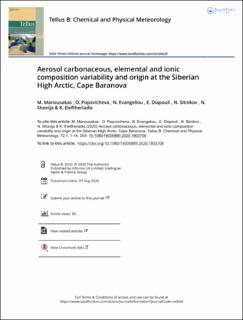| dc.contributor.author | Manousakas, Manousos | |
| dc.contributor.author | Popovicheva, Olga | |
| dc.contributor.author | Evangeliou, Nikolaos | |
| dc.contributor.author | Diapouli, Evangelia | |
| dc.contributor.author | Sitnikov, Nikolay | |
| dc.contributor.author | Shonija, N. | |
| dc.contributor.author | Eleftheriadis, Konstantinos | |
| dc.date.accessioned | 2020-08-31T14:49:02Z | |
| dc.date.available | 2020-08-31T14:49:02Z | |
| dc.date.created | 2020-08-28T09:43:33Z | |
| dc.date.issued | 2020 | |
| dc.identifier.citation | Tellus. Series B, Chemical and physical meteorology. 2020, 72, 1-14. | en_US |
| dc.identifier.issn | 0280-6509 | |
| dc.identifier.uri | https://hdl.handle.net/11250/2675724 | |
| dc.description.abstract | Aerosol particles are major short-lived climate forcers, because of their ability to interact with incoming solar radiation. Therefore, addressing mean levels and sources of Arctic aerosols is of high importance in the battle against climate change, due to the Arctic amplification. In the Eastern Arctic, from Finland to Alaska, only one monitoring station exists (HMO Tiksi) and the levels of the Arctic aerosols are usually recorded by sporadic campaigns, while other stations exist in Canada, Finland and Europe. From April 2015 to December 2016, the research station "Ice Base Cape Baranova" (79°16.82'N, 101°37.05'E), located on the Bolshevik island was established in the Siberian high Arctic. Samples were analyzed for equivalent Black Carbon (eBC), Organic Carbon (OC), Elemental Carbon (EC), water-soluble ions, and elements. To identify the spatial origin of the sources, the Potential Source Contributions Function (PSCF) was used in combination with FLEXPART emission sensitivities. OC is the most dominant PM compound in the Ice Cape Baranova station and mostly originates from gas flaring and other industrial regions at lower latitudes, as well as from biomass burning during summertime. Sulfate concentrations were affected by anthropogenic sources in the cold seasons and by natural sources in the warm ones showing distinct seasonal patterns. K+ and Mg2+ originate from sea-salt in winter and from forest fires in summer. The interannual variability of eBC was in good agreement with the general Arctic seasonal trends and was mainly affected by gas flaring, low latitude industrial sources and from biomass burning emissions. Cl− depletion was very low, while Na+ and Cl− originated from the locally formed sea spray. | en_US |
| dc.language.iso | eng | en_US |
| dc.rights | Navngivelse 4.0 Internasjonal | * |
| dc.rights.uri | http://creativecommons.org/licenses/by/4.0/deed.no | * |
| dc.title | Aerosol carbonaceous, elemental and ionic composition variability and origin at the Siberian High Arctic, Cape Baranova | en_US |
| dc.type | Peer reviewed | en_US |
| dc.type | Journal article | en_US |
| dc.description.version | publishedVersion | en_US |
| dc.rights.holder | © 2020 The Author(s) | en_US |
| dc.source.pagenumber | 1-14 | en_US |
| dc.source.volume | 72 | en_US |
| dc.source.journal | Tellus. Series B, Chemical and physical meteorology | en_US |
| dc.identifier.doi | 10.1080/16000889.2020.1803708 | |
| dc.identifier.cristin | 1825680 | |
| dc.relation.project | EC/H2020/689443 | en_US |
| cristin.ispublished | true | |
| cristin.fulltext | original | |
| cristin.qualitycode | 1 | |

